
Kentville Railroad Yard 1937

I'll Be With You In Apple Blossom Time (1940) - The Andrews Sisters
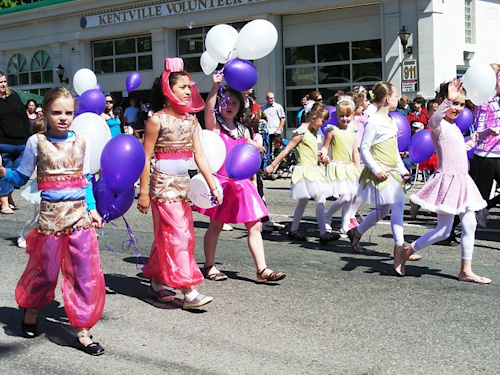


The History of the Apple Blossom Festival
Early colonists from Europe introduced the sweet scent of apple
blossoms to the Annapolis Valley as they brought seeds, grains, fruits
and vegetables to the new land. A plaque on the reconstructed gristmill
in Lequille, Annapolis County, notes the site as the first “farm”. From
the 1600’s on, production of apples was an industry with both the
Planters and later the Loyalists planting orchards up and down the
Valley. In peak years, nearly 3 million barrels of apples were
harvested, valuable crops indeed!
The aroma of the blossoms in May and June, along with the natural beauty of the bloom, made the advent of spring even more of an occasion. Local boards of trade and community councils had talked of a spring carnival at blossom time but not until 1933 did talk turn into action.
In 1933, the first official Apple Blossom Festival was celebrated with Reg Caldwell as President. Other committee members included Mayor G. W. Lyons, H. O. Bishop, C. C. Eidt, G. R. Palmeter, R. W. Harris, M. A. Girvan, Dr. J. P. McGrath, T. P. Stent, G. L. Calkin and R. D. L. Bligh, all of Kentville. The committee had convinced the provincial government of a blossom Festival’s value as a tourist attraction, and the government provided some financial assistance.
Original objectives of the Festival were to make the Valley’s apple industry better known throughout North America and Europe; to publicize the scenic beauty of the area and the historic background of Longfellow’s Land of Evangeline; and to provide an opportunity to foster and develop local talent through participation in Festival events.
Little has changed from the successful format of the inaugural event. There was a contest involving selection of a blossom queen from among princesses representing several apple-growing communities. The queen was chosen by a panel of judges who based their decision on character, poise and personality of the young ladies. Mary Armour, of Middleton, was Queen Annapolisa I. Her coronation took place at the Dominion Experimental Station in Kentville, and on hand to cover the event was the Associated Screen News of Montreal, making newsreels to be shown in motion picture theatres throughout Canada and the United States.
Two years later, the Festival was incorporated by the provincial legislature and is to this day the only Festival that holds this status in the province.
By the time World War II began, the Festival had become a three-day event and by this time, too, it had become internationally renowned. During the war years, it was quite natural that the Festival would assume a new role, that of fundraising for war-related activities. More than $4,000 was donated to the Queen’s Fund, Red Cross and other such organizations.
A large press corps was present for these occasions, and a suite was set aside in the Cornwallis Inn as a working area for the newsmen. In 1945, James Fitzpatrick, whose newsreels were syndicated as Voice of the Globe, and sold around the world, was on hand with a crew of cameramen, scriptwriters and make-up artists for the filming of the coronation. For this occasion, the coronation took place in a Port Williams orchard.
With the declaration of peace, the Festival was expanded to a four-day event with Monday being added for a “royal tour” of participating communities, usually from Windsor to Digby. Instituted by the late C. W. Fairn, of Wolfville, the tour included a short ceremony at each stop. The local princess, as well as the queen, would be featured, and there would be a band on hand to play during the stop.
During one Festival, a motion picture was made of “an apple blossom wedding” with Miss Gladys Wade portraying the bride, and Philip Donat, the groom. Miss Wade was a member of a well-known Kentville family. Mr. Donat was a brother of British film star Robert Donat, and the father of Peter Donat, a movie and television actor. Mr. Donat, possessed of a fine baritone voice, was also a member of a male quartet, which entertained at many of the early Festivals.
For many years, an historical pageant formed part of the blossom festival program. Directed by Miss Daisy Foster of Halifax, local people made up the cast. Two of them, J. Lorimer Ilsley and George C. Nowlan, later became ministers of finance in the Canadian government. Mr. Nowlan played the lead role of Glooscap in one of these pageants.
Over the years, the Festival grew to include towns and communities from Windsor to Digby, with generations of families who have proudly hosted princesses, watched parades and been a part of nearly eight decades of celebration.
The Present
The Apple Blossom Festival annually opens Nova Scotia’s tourist season and continues to enjoy national and international recognition. In 1988 and 1991, the American Bus Association selected it as one of the Top 100 tourist events in North America. In 2001, Canada Post named the Festival as one of the top 10 tourist attractions in Canada and simultaneously released the Apple Blossom Festival Stamp in 2001 for the 69th Festival. In 2002, the Royal Canadian Mint presented the Annapolis Valley Apple Blossom Festival – the 2002 50-Cent Sterling Silver Coin.
For the first 30 or more years, Fred Hockey, head of the plant pathology division of the Kentville Experimental Station, named the dates of Festivals, working on a ‘best guess’ for perfect blossoms. For scheduling purposes, dates for the Festival are now set five years in advance. The last Wednesday in May is the Official First Day of Festival each year.
The Apple Blossom Festival has grown to embrace the many communities that make up the Annapolis Valley. Opening Night is one event that moves from community to community and is an opportunity to honor the contributions and dedication of the many, many Festival volunteers, while highlighting that community. The reigning Queen Annapolisa and new princess candidates are special guests at a formal tea held in a Valley community on the Friday afternoon. It is there that each candidate has the chance to speak publicly as an important part of the leadership competition procedure.
The Friday night Coronation is at Acadia University Hall in Wolfville, followed by the Queen’s Scholarship Ball. Many of the princess candidates are studying at post-secondary schools and this financial contribution is most welcome. The honour of crowning the new Queen Annapolisa goes each year to a local or visiting dignitary or special guest of the Festival, assisted by the retiring queen.
Not all the crowds are at the Coronation as thousands of people are entertained by music, humor and many family activities in the parklands of Kentville. This event changes slightly from year to year, reflecting the current entertainment trends. One of the most spectacular events for many residents and guests is the fireworks show that wrap up Friday evening; a truly spectacular show that has the crowds coming back each year.
From the very beginning, children have been part of the Festivals. Prior to the war, school choirs and bands from all over the province performed. Present-day Festivals feature children in what well may be Canada’s largest Children’s Parade on the Saturday morning of Festival. It is so long is nearly meets itself as the children parade through the Festival birth-town of Kentville.
The Grand Street parade on Saturday afternoon is in Kentville and is truly one of the Festival’s premier events as thousands line the streets in all sorts of weather to be a part of this celebration. Entries for the Grand Street Parade assemble in New Minas and at Kentville Agricultural Centre and proceed to Kentville Memorial Park. The hundreds of entries that make up one of Canada’s largest street parades include bands, marching units, equestrian entries; princess floats from participating communities, and floats representing business firms and organizations.
The time after the parade also gives an opportunity for visitors to travel the roads of the Valley, enjoying the display of blossoms in apple orchards. The Royal Party spends much of the weekend visiting local nursing homes, schools and other local stops, enjoying the conversations and connections, learning much about the Valley and the people who call it home.
The Royal tour is held on the Monday after Festival weekend as the Royal Party and many of the Apple Blossom Festival Board members make their way to nursing homes, schools and other community venues in a daylong marathon of visiting. The local princess representative is given an opportunity to “show off” her home community. Most representatives find this stop an ideal opportunity to express her appreciation to the residents for selecting her to represent them and to the committees who work so hard to support her. The Festival concludes at the end of the Valley-wide royal tour.
Over the years, Festival queens have acted as goodwill ambassadors for the Valley and the province, at functions such as the Imperial Fruit Show at Cardiff, Wales, which Queen Annapolisa III Margaret Messenger attended in 1935. Great Britain reciprocated the following year when Florence Small of London represented the Farmers’ Union at the Apple Blossom Festival. The 1937 queen, Babs Harris, Wolfville, was guest of honour at the Shenandoah Valley Apple Blossom Festival in Winchester, Virginia. Enroute, she made public appearances in New York and Washington. Janet Kinsman, Queen Annapolisa XXVII, represented the Valley on a New England tour, as did Queen Annapolisa XXX Carol Kerr, in 1962.
The Valley always anticipates fair weather for its Festival. No parade is or has ever been cancelled or postponed because of inclement weather, nor have many other outdoor events.
There have been many changes in apple production since the first Festival in 1933. Old orchards have made way for newer varieties of apple trees. Most trees now are smaller than the traditional umbrella-shaped trees, but there are more to the acre and more fruit to the tree. The Festival continues to be financially supported by the three levels of government, the Booster Club formed by the sixteen towns and communities, the Patrons of the business community and by individuals who see the value of celebrating a springtime spectacle that continues to win the hearts of all who participate. Of course the largest group of supporters are the faithful crowds that line streets, attend events and generally give Festival the spirit it needs to succeed.
The spectacle and the scent of fruit trees in bloom never changes, luring visitors from near and far. Apple blossom time signals the end of another winter, and offers the promise of a new growing season.
Come join in the celebration, be a part of the Festival family!
The aroma of the blossoms in May and June, along with the natural beauty of the bloom, made the advent of spring even more of an occasion. Local boards of trade and community councils had talked of a spring carnival at blossom time but not until 1933 did talk turn into action.
In 1933, the first official Apple Blossom Festival was celebrated with Reg Caldwell as President. Other committee members included Mayor G. W. Lyons, H. O. Bishop, C. C. Eidt, G. R. Palmeter, R. W. Harris, M. A. Girvan, Dr. J. P. McGrath, T. P. Stent, G. L. Calkin and R. D. L. Bligh, all of Kentville. The committee had convinced the provincial government of a blossom Festival’s value as a tourist attraction, and the government provided some financial assistance.
Original objectives of the Festival were to make the Valley’s apple industry better known throughout North America and Europe; to publicize the scenic beauty of the area and the historic background of Longfellow’s Land of Evangeline; and to provide an opportunity to foster and develop local talent through participation in Festival events.
Little has changed from the successful format of the inaugural event. There was a contest involving selection of a blossom queen from among princesses representing several apple-growing communities. The queen was chosen by a panel of judges who based their decision on character, poise and personality of the young ladies. Mary Armour, of Middleton, was Queen Annapolisa I. Her coronation took place at the Dominion Experimental Station in Kentville, and on hand to cover the event was the Associated Screen News of Montreal, making newsreels to be shown in motion picture theatres throughout Canada and the United States.
Two years later, the Festival was incorporated by the provincial legislature and is to this day the only Festival that holds this status in the province.
By the time World War II began, the Festival had become a three-day event and by this time, too, it had become internationally renowned. During the war years, it was quite natural that the Festival would assume a new role, that of fundraising for war-related activities. More than $4,000 was donated to the Queen’s Fund, Red Cross and other such organizations.
A large press corps was present for these occasions, and a suite was set aside in the Cornwallis Inn as a working area for the newsmen. In 1945, James Fitzpatrick, whose newsreels were syndicated as Voice of the Globe, and sold around the world, was on hand with a crew of cameramen, scriptwriters and make-up artists for the filming of the coronation. For this occasion, the coronation took place in a Port Williams orchard.
With the declaration of peace, the Festival was expanded to a four-day event with Monday being added for a “royal tour” of participating communities, usually from Windsor to Digby. Instituted by the late C. W. Fairn, of Wolfville, the tour included a short ceremony at each stop. The local princess, as well as the queen, would be featured, and there would be a band on hand to play during the stop.
During one Festival, a motion picture was made of “an apple blossom wedding” with Miss Gladys Wade portraying the bride, and Philip Donat, the groom. Miss Wade was a member of a well-known Kentville family. Mr. Donat was a brother of British film star Robert Donat, and the father of Peter Donat, a movie and television actor. Mr. Donat, possessed of a fine baritone voice, was also a member of a male quartet, which entertained at many of the early Festivals.
For many years, an historical pageant formed part of the blossom festival program. Directed by Miss Daisy Foster of Halifax, local people made up the cast. Two of them, J. Lorimer Ilsley and George C. Nowlan, later became ministers of finance in the Canadian government. Mr. Nowlan played the lead role of Glooscap in one of these pageants.
Over the years, the Festival grew to include towns and communities from Windsor to Digby, with generations of families who have proudly hosted princesses, watched parades and been a part of nearly eight decades of celebration.
The Present
The Apple Blossom Festival annually opens Nova Scotia’s tourist season and continues to enjoy national and international recognition. In 1988 and 1991, the American Bus Association selected it as one of the Top 100 tourist events in North America. In 2001, Canada Post named the Festival as one of the top 10 tourist attractions in Canada and simultaneously released the Apple Blossom Festival Stamp in 2001 for the 69th Festival. In 2002, the Royal Canadian Mint presented the Annapolis Valley Apple Blossom Festival – the 2002 50-Cent Sterling Silver Coin.
For the first 30 or more years, Fred Hockey, head of the plant pathology division of the Kentville Experimental Station, named the dates of Festivals, working on a ‘best guess’ for perfect blossoms. For scheduling purposes, dates for the Festival are now set five years in advance. The last Wednesday in May is the Official First Day of Festival each year.
The Apple Blossom Festival has grown to embrace the many communities that make up the Annapolis Valley. Opening Night is one event that moves from community to community and is an opportunity to honor the contributions and dedication of the many, many Festival volunteers, while highlighting that community. The reigning Queen Annapolisa and new princess candidates are special guests at a formal tea held in a Valley community on the Friday afternoon. It is there that each candidate has the chance to speak publicly as an important part of the leadership competition procedure.
The Friday night Coronation is at Acadia University Hall in Wolfville, followed by the Queen’s Scholarship Ball. Many of the princess candidates are studying at post-secondary schools and this financial contribution is most welcome. The honour of crowning the new Queen Annapolisa goes each year to a local or visiting dignitary or special guest of the Festival, assisted by the retiring queen.
Not all the crowds are at the Coronation as thousands of people are entertained by music, humor and many family activities in the parklands of Kentville. This event changes slightly from year to year, reflecting the current entertainment trends. One of the most spectacular events for many residents and guests is the fireworks show that wrap up Friday evening; a truly spectacular show that has the crowds coming back each year.
From the very beginning, children have been part of the Festivals. Prior to the war, school choirs and bands from all over the province performed. Present-day Festivals feature children in what well may be Canada’s largest Children’s Parade on the Saturday morning of Festival. It is so long is nearly meets itself as the children parade through the Festival birth-town of Kentville.
The Grand Street parade on Saturday afternoon is in Kentville and is truly one of the Festival’s premier events as thousands line the streets in all sorts of weather to be a part of this celebration. Entries for the Grand Street Parade assemble in New Minas and at Kentville Agricultural Centre and proceed to Kentville Memorial Park. The hundreds of entries that make up one of Canada’s largest street parades include bands, marching units, equestrian entries; princess floats from participating communities, and floats representing business firms and organizations.
The time after the parade also gives an opportunity for visitors to travel the roads of the Valley, enjoying the display of blossoms in apple orchards. The Royal Party spends much of the weekend visiting local nursing homes, schools and other local stops, enjoying the conversations and connections, learning much about the Valley and the people who call it home.
The Royal tour is held on the Monday after Festival weekend as the Royal Party and many of the Apple Blossom Festival Board members make their way to nursing homes, schools and other community venues in a daylong marathon of visiting. The local princess representative is given an opportunity to “show off” her home community. Most representatives find this stop an ideal opportunity to express her appreciation to the residents for selecting her to represent them and to the committees who work so hard to support her. The Festival concludes at the end of the Valley-wide royal tour.
Over the years, Festival queens have acted as goodwill ambassadors for the Valley and the province, at functions such as the Imperial Fruit Show at Cardiff, Wales, which Queen Annapolisa III Margaret Messenger attended in 1935. Great Britain reciprocated the following year when Florence Small of London represented the Farmers’ Union at the Apple Blossom Festival. The 1937 queen, Babs Harris, Wolfville, was guest of honour at the Shenandoah Valley Apple Blossom Festival in Winchester, Virginia. Enroute, she made public appearances in New York and Washington. Janet Kinsman, Queen Annapolisa XXVII, represented the Valley on a New England tour, as did Queen Annapolisa XXX Carol Kerr, in 1962.
The Valley always anticipates fair weather for its Festival. No parade is or has ever been cancelled or postponed because of inclement weather, nor have many other outdoor events.
There have been many changes in apple production since the first Festival in 1933. Old orchards have made way for newer varieties of apple trees. Most trees now are smaller than the traditional umbrella-shaped trees, but there are more to the acre and more fruit to the tree. The Festival continues to be financially supported by the three levels of government, the Booster Club formed by the sixteen towns and communities, the Patrons of the business community and by individuals who see the value of celebrating a springtime spectacle that continues to win the hearts of all who participate. Of course the largest group of supporters are the faithful crowds that line streets, attend events and generally give Festival the spirit it needs to succeed.
The spectacle and the scent of fruit trees in bloom never changes, luring visitors from near and far. Apple blossom time signals the end of another winter, and offers the promise of a new growing season.
Come join in the celebration, be a part of the Festival family!
http://appleblossom.com/history/
Passport 2 the Valley
NOVA SCOTIA TOURISM
------------------
NOVA SCOTIA'S PROVINCIAL FLOWER
-
- It is one of the very first wildflowers to be make its appearance in
the spring. It creeps along the forest floor and its pink and white
blossoms seemingly hide themselves from view underneath its oval,
evergreen and leathery leaves. It is one of nature's most fragrant
plants; put the blossoms to your nose and breath deep -- Ah! Spring has
arrived. The Mayflower likes to grow in well drained acidic soil in open
lands. The Mayflower is the floral emblem of the Province of Nova
Scotia (1901) and the State Flower of Massachusetts (1918).
Note: Fergusson wrote an article on the Mayflower in the The Nova Scotia Historical Quarterly (NSHQ#4:1).
- It is one of the very first wildflowers to be make its appearance in
the spring. It creeps along the forest floor and its pink and white
blossoms seemingly hide themselves from view underneath its oval,
evergreen and leathery leaves. It is one of nature's most fragrant
plants; put the blossoms to your nose and breath deep -- Ah! Spring has
arrived. The Mayflower likes to grow in well drained acidic soil in open
lands. The Mayflower is the floral emblem of the Province of Nova
Scotia (1901) and the State Flower of Massachusetts (1918).

|
_______________________________
The Provincial Bird
The Osprey was made Nova Scotia's provincial bird in 1994. The birds use the same nests each year, hatching 2-3 eggs per year.The osprey is 'a raptor' or meat eating bird that feeds mainly on fish.

---------------
“Golden lads and girls all must,
as chimney sweepers, come to dust” —William Shakespeare
-
- Everybody knows what a dandelion looks like. What appears as one
brilliant yellow flower at the top of a long hollow stem, is in fact
many small flowers which spring forth from a small disk.
(Notwithstanding this very showy flower, the dandelion reproduces itself
wholly non-sexually and does not require the visits of insects.) The stem arises from a rosette of basal
leaves. The leaves are jagged and its the leaves from which the plant
gets its name, in French, "dent de lion," lion's teeth. Note the
"reflexed sepals"
below the flower head. And, as all children know, the stems when broken
exude a milky substance which will dry as black smudges on the hand.
And, too, who hasn't blown the tiny parachutes off, into the air, from
the round, fluffy, translucent seedballs of the dandelion. There are,
seemingly, two types: the one smaller and close to the ground, and the
other taller and erect, more often found in the open wild and not hiding
down amidst the grass of your front lawn. The dandelion was introduced
by Europeans. Dandelions are one of the first wild flowers we see and
thrive in Nova Scotia through the entire growing season. Seemingly they
will grow everywhere, especially on people's lawns.
Edibility: The young leaves -- before the flower blooms, and, only if picked away from where people spread their poisons -- make a very tasty and healthy meal: "... very nutritious, containing Vitamins A, C; thiamine, riboflavin, calcium, sodium and potassium." So, Dandelion greens can be treated much like spinach, cooked or raw. They may, however, prove to be a bit bitter; so, like brussel sprouts or fiddle heads (fern sprouts), they should be soaked for an hour or so in water after being sprinkled with baking soda; rinse well with cold water in a colander before cooking.
Roots can be dried and used as a coffee substitute. (See Griffin.)
"The young roots, dug before the last frost of spring, make a good cooked vegetable. To prepare them, peel, slice and boil in two waters with a pinch of baking soda. These roots can also be made into a coffee. They can be dug any time of the year for this. Just roast them for four hours, grind them into small pieces and perk in boiling water, and you've got a good drink." (McLeod, p. 34.)
Wine can be made out of the flowers. A recipe can be found in McLeod (p. 34).
Reference earlier was made to the flower stems which when broken exude a milky substance, according to Clevely this, while temporarily staining the skin, soothes burns and stings.
- Everybody knows what a dandelion looks like. What appears as one
brilliant yellow flower at the top of a long hollow stem, is in fact
many small flowers which spring forth from a small disk.
(Notwithstanding this very showy flower, the dandelion reproduces itself
wholly non-sexually and does not require the visits of insects.) The stem arises from a rosette of basal
leaves. The leaves are jagged and its the leaves from which the plant
gets its name, in French, "dent de lion," lion's teeth. Note the
"reflexed sepals"
below the flower head. And, as all children know, the stems when broken
exude a milky substance which will dry as black smudges on the hand.
And, too, who hasn't blown the tiny parachutes off, into the air, from
the round, fluffy, translucent seedballs of the dandelion. There are,
seemingly, two types: the one smaller and close to the ground, and the
other taller and erect, more often found in the open wild and not hiding
down amidst the grass of your front lawn. The dandelion was introduced
by Europeans. Dandelions are one of the first wild flowers we see and
thrive in Nova Scotia through the entire growing season. Seemingly they
will grow everywhere, especially on people's lawns.

|
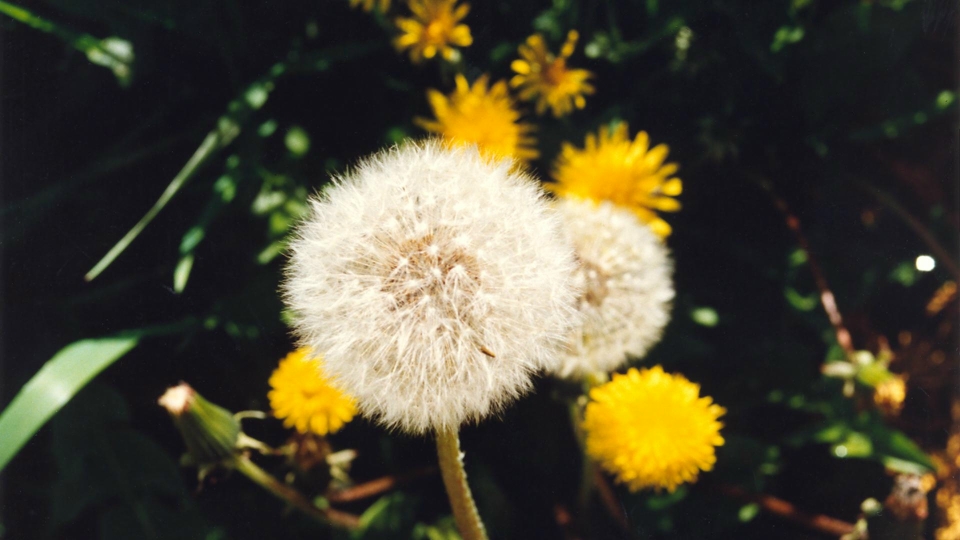
|
_______________________________
Little yellow flowers just
the start at Wallace Dandelion Fest
AARON BESWICK TRURO BUREAU
-Published May 27, 2015 - 10:51am
photo
Dandelions grow over Wallace
resident Zella Perry’s septic field, with her pasture in the background. (ZELLA
PERRY)
Zella Perry took a picture
of the dandelions growing over her septic field.
And to the right set of
eyes, they were pretty.
“So we tried the dandelion
photography contest, but we only had eight photos and Zella took three of
them,” said Doug Perry, Zella’s husband and organizer of the Wallace Dandelion
Festival.
“We tried lawn mower races,
but we had to plead (with people to participate) and haul lawnmowers for
everyone, and no one came — so that died. We had an antique tractor display one
year, but no one bothered to look at it. We had antique cars one year, but no
one bothered to look at them either. There were ball games other years, but
we’re running out of young people, so those died, too.”
SEE ALSO: Let's halt the war
on the humble dandelion
About the only thing that
won’t die is the Dandelion Festival itself.
On Saturday, the small
Cumberland County fishing community of Wallace will open its doors for its
eighth annual Dandelion Festival.
Through painful experience,
the organizers have learned that yard sales are a sure bet.
So starting early Saturday
morning, the J. Millard Charman Community Centre will host a community yard
sale with local churches and community groups. There will be live music and
pictures of dandelions drawn by students at Wallace Consolidated Elementary
School.
“People come out of their
houses from far and wide for the yard sales,” said Doug Perry.
“It won’t just be in the
hall, but there will be yard sales up in North Wallace and right up to Six Mile
Road.”
The lobster fleet will be
landing their catch at about noon, so organizers are encouraging visitors to go
down to the wharf, talk to the fishermen and buy some lobster.
Then, starting at 4 p.m.,
there will be a supper at the Masonic Lodge.
And the festival is about
more than raising money by reselling the unwanted household knick-knacks and a
feast of meat and potatoes in the old lodge overlooking Wallace Bay.
It’s about people coming out
of their houses and talking to one another.
That, said Perry, is what
makes a community.
And that is why the festival
is so aptly named after a flower that refuses to die.
Because, like Wallace, which
has seen its young people drained away by the same irresistible forces
shuttering churches and little stores throughout Nova Scotia, the dandelion is
a survivor.
Communities don’t exist
automatically just because people live next to one another.
They are watered by the
seemingly minor day-to-day interactions that occur when those neighbours leave
their houses, run into one another at a store, post office or community meal,
share gossip and care for the goings-on in one another’s lives.
“The dandelion is a noble
flower,” said Perry.
“Every year, we get
contacted by people who like dandelions and by people who hate them and don’t
know why we’re doing (the festival). To them, I say, ‘Smile a little bit, and
you’ll learn a good lesson about life.’”
---------------
Dandelion Wine
Recipe by Elle
"This very old recipe
utilizes the bane of homeowners: the dandelion! I found this in 1993 when a
flood left our front yard full of beautiful, very large dandelions. The blossoms
CANNOT have been sprayed with any pesticides, and should be thoroughly
rinsed."
Ingredients Edit and Save
Original recipe makes 4 quart
jars Change Servings
1 quart yellow dandelion
blossoms, well rinsed
·
1 gallon boiling water
·
1 (.25 ounce) package active dry
yeast
· 8 cups white sugar
·
1 orange, sliced
·
1 lemon slice
Directions
Place dandelion blossoms in the boiling water, and allow to stand for 4
minutes. Remove and discard the blossoms, and let the water cool to 90 degrees
F (32 degrees C).
Stir in the yeast, sugar, orange slices, and lemon slice; pour into a
plastic fermentor, and attach a fermentation lock. Let the wine ferment in a
cool area until the bubbles stop, 10 to 14 days. Siphon the wine off of the
lees, and strain through cheesecloth before bottling in quart-sized, sterilized
canning jars with lids and rings. Age the wine at least a week for best flavor.
--------------------
How to make dandelion wine
The humble and underappreciated
dandelion has medical and culinary uses, foremost among which is flavouring a
fine country wine
John Wright's dandelion wine.
Photograph: John Wright
Wednesday 4 April 2012 10.00 BST
Last modified on Wednesday 21 May 2014 00.41 BST
Dandelion wine making is an
important part of the home-brewer's calendar, and it's a wonderful drink.
Although the flowers can make an appearance at any time of the year, 99% of
them bloom in a flamboyant spring flush which runs from the end of March to the
beginning of May.
Roadsides and fields, hedgerows
and untended lawns turn golden and a single field may blossom with a million
flowers - one of the greatest, but least appreciated, sights in the
countryside. Even close-up it is a beautiful flower - if it smelled of sweet
pea or roses we would fill our houses with them. But then if it were a fragrant
flower it would not make the splendid wine it does.
I sometimes make a syrup from the petals to use instead of plain sugar in cakes or to pour over crepes and here you can detect the dandelion's special flavour – barley sugar. If you have ever eaten a dandelion leaf or tasted the white sap of the stem you will know how bitter this plant is. The flower too is bitter but this imparts a pleasant astringency to the wine. Incidentally if you would like to eat the leaves in a salad, upturn a flower pot over a likely looking plant to blanch the new growth of leaves.
I sometimes make a syrup from the petals to use instead of plain sugar in cakes or to pour over crepes and here you can detect the dandelion's special flavour – barley sugar. If you have ever eaten a dandelion leaf or tasted the white sap of the stem you will know how bitter this plant is. The flower too is bitter but this imparts a pleasant astringency to the wine. Incidentally if you would like to eat the leaves in a salad, upturn a flower pot over a likely looking plant to blanch the new growth of leaves.
You may have noticed that
dandelions are variable in appearance. This is because the dandelion is really
a species-complex with over two hundred micro-species in this country alone. We
have come across this before with the blackberry which has even more
micro-species. They all reproduce without sex by a process called apomixes –
they are clones.
Collecting dandelion flowers for
winemaking. Photograph: John Wright
As with any flower destined for
the kitchen, the dandelion should be picked in full sun and preferably in the
morning. Dandelions shut up shop for the night by closing their petals and will
even do this after being picked, so you will need to start your wine the very
moment you get home. At least the flowers are easy to pick (more than can be said for gorse flowers) and the
gallon of blossoms needed can be collected in 20 minutes. I normally use just
the petals, though there is no pressing reason not to use the whole flower – it
just adds a little more tang – though you will need a little less than a gallon
if you do. Hold each flower by the calyx (the green bit below the petals) and
snip off the petals with scissors into a clean fermenting bucket, not worrying
about getting green bits in the mix from time to time. The recipe itself is
pretty standard fare and very easy, producing a rich, strong, medium sweet
wine.
Dandelion wine
The petals from enough complete dandelion flowers to loosely fill a gallon container
4.5 litres of water
1.5kg sugar
Zest and juice of 4 lemons
500g raisins, chopped or squashed by putting in a carrier bag and pounding, or 200ml can of white grape juice concentrate
1 sachet of white wine yeast
Yeast nutrient
Boil the water and pour over the
petals. Cover and leave for a couple of days, stirring occasionally.
Pour everything into a large
saucepan and add the lemon zest, bring to the boil then stir in the sugar until
dissolved. Continue to boil for five minutes. Take off the heat and add the
lemon juice and the crushed raisins or grape juice concentrate.
Clean the fermenting bucket
thoroughly using a campden tablet, pour in the mix and cover until cool. Add
the yeast and yeast nutrient and cover. Ferment for three or four days then
transfer into a demijohn using a sterilised sieve and funnel. Fit a bubble trap
and allow to ferment for a couple of months, rack-off into a fresh demijohn and
leave until clear then bottle. Ray
Bradbury would be proud.
-----------------------------
-----------
Discovering Dandelion Uses: The Loathed Weed and Cure-All of the Lawn
4/18/2012 11:16:28 AM
Tags:
Jennifer Heinzel, Dandelion, Herb To Know, Herb Profile, Weed, Hated Weed, Cherished Weed, Dandelion Uses, Dandelion Health Benefits, History Of Dandelion, Taraxacum Officinale, Tips
 Freelance
herbal writer, community herbalist and medicine maker Jennifer Heinzel
hails from the cold city of Minneapolis, Minnesota. Visit Thymes Ancient Remedies to read more from Jennifer.
Freelance
herbal writer, community herbalist and medicine maker Jennifer Heinzel
hails from the cold city of Minneapolis, Minnesota. Visit Thymes Ancient Remedies to read more from Jennifer.“Golden lads and girls all must, as chimney sweepers, come to dust” —William Shakespeare
Dandelion was one of the most loved and “esteemed plants of the herbalist," especially by the famous Arabian herbalist Avicenna, and was referred to as “blessed medicine" in the 18th century in Europe. Though a native to Greece, it has been used medicinally and as food throughout the world, but more so in Germany, China and England. Across the world it has been loved by foragers and herbalists alike, such as Rosemary Gladstar who is “convinced, [that dandelion] is one of the greatest herbs of all time. The entire plant is restorative and rejuvenating." Besides its popular reputation by historical and current-day herbalists alike, there is no other herb in the United States that is so “well known, so easily recognized, so much hated, so systematically singled out for extermination—and so little understood—as the dandelion." Despite most people in the U.S. seeing the dandelion as only a weed, it is “ironically just those long, tenacious roots which contain the major portion of its wealth in natural minerals and alkaloids!” So before you spray your lawn, think twice about exterminating this restorative herb.
The dandelion (Taraxacum officinale), which is a part of the Asteracea family, ironically has many folk names for being such an aggressive, but medicinally useful, weed. Some of the more famous names include wild endive, blow ball, lion’s teeth, goats beard, fairy clock and peasant’s cloak, though it’s more interesting how the dandelion got its name. It started as the Latin Dens Leonis, to the Greek Leotodum. Once it crossed borders again to France, it changed to the French’s dent-de-lion, and lastly to the current day English version dandelion. Also, true to its name, the dandelion possesses long, lion teeth-like leaves that emerge from the taproot (usually around 2 to 12 inches long), forming a rosette of green leaves.

This is an historical profile of the tenacious dandelion.
Photo courtesy Edible Communities Publications
The uses of dandelion are as vast, boundless and varied as its folk names, including China’s more than 1,000-year use of it in the treatment of breast cancer, to being very “effectual for the obstructions of the liver, gall and spleen." It was also noted to effectively treat jaundice and urinary infections, according to the famous English botanist Nicholas Culpeper. One of the most medicinally concentrated parts is the root (for when fresh leaves are not available). The roots are best dug up in the fall or spring of the second year. This was traditionally done so by the French-Canadians; Icelanders fried the roots as well. Another way people knew of dandelion, though not to my surprise, was as a magical plant. The dandelion was believed to increase a person’s physhic powers. In the 16th century a man named Matthiolus recorded that “magicians say that if a person rub himself all over with [dandelion], he will everywhere be welcome and obtain what he wishes." Also in this century in England, John Evelyn noted that the leaves of the famous bitter green had “been sold at most Herb Shops about London for being a wonderful Purifier of the Blood." Another famous English herbalist, John Gerard, compared dandelion to chicory (called ‘succorie’ at the time), because it was another coffee substitue, and “thrived especially in gardens and ‘highe ways much troden.'"
Another famous herbalist of the 19th through the 20th centuries, Maude Grieve, stated that dandelion tea is “efficacious in bilious affections.” In fact, most herbalists believe that the beneficence of such of tea is almost boundless. In Eastern medicine, they traditionally used dandelion to heal liver complaints; they also used the coarsely ground root to heal snake bites and to inhibit the growth of tumor cells in a mixture along with kelp and gotu kola.
Being so rich in vitamins and minerals, it’s no wonder that dandelion is so widely used and grown throughout the world. Dandelion is very rich in protein, magnesium, phosphorous, iron, niacin, riboflavin, magnesium, potassium and vitamins A, B, C, D, G and E. The leaves, amazingly enough, contain 7,000 units of vitamin A per ounce. In comparison to lettuce being 1,200 units per ounce of vitamin C, and to carrot being 1,275 units per ounce is quite astounding. With dandelion containing many vitamins and minerals, it’s no wonder that it treats many disorders such as anemia, IBS and sluggish bowel. It also improves the health of all digestive organs, including the liver, gallbladder and kidneys, and treats blood sugar problems. Dandelion treats the nutrient-deficient ailment anemia very well, since anemia is caused by a deficiency of nutritive salts present in the blood. With dandelion’s high levels of potassium, iron and vitamin B, this especially helps in the treatment of anemia, because this ailment is also caused from a the lack of iron, B-12 and folic acid.

Dandy-Lion in the Ecovillage of Findhorn, Scotland
Photo by Jennifer Heinzel
Lastly, the glandular activity, which is stimulated with the juice of the entire plant, is used by European herbalists and is used to improve lymph drainage,when mixed with other herbs such as mullein, cleavers and calendula. Along with improving the intake of nutrients—being a nutrient-dense herb in its own right—the dandelion also improves the health of all digestive organs, and thus improves all digestion-related-ailments. Therefore, it can improve appetite, ease sluggish-bowel,and improve the assimilation of nutrients. A Belgian study, using a five-herb combination with dandelion, showed that more than “95 percent of IBS sufferers were pain-free after 15 days of treatment and also improved regularity." Dandelion is a blood purifier, removes poisons and toxins from the blood and helps the kidneys and liver remove toxins.
Having mentioned historical ways to take this medicine, many people prefer taking it as a decoction or as a wine. Having done none of these much, I much prefer to eat my medicine. My favorite way to eat the dandelion is in an omelet and here is my own recipe:
Wild Green & Dandelion Omelet
SERVES 1• 2 to 3 fresh local eggs
• Sweet peppers, chopped into small squares
• 1 to 2 handfuls fresh dandelion greens, cut up
• About 3 sprigs lamb's quarters, ripped up
• 1 to 2 garlic cloves, finely chopped
• 1 sprig tarragon, chopped
• About 3 chives, cut up
• Goat cheese
• Salsa
1. Scramble the eggs in a bowl with a fork. Pour into a heated oiled or sprayed pan. After about 1 minute add the sweet peppers, dandelion greens and lamb's quarters. Then, after 1 to 2 minutes later, add the garlic, tarragon and chives.
2. Flip one side of the omelet to cover the other half of it. Turn off the heat and cover with goat cheese (or another cheese based on personal taste), salt, pepper and salsa. ENJOY!!
References
+ For more information on folk names, traditional uses and a Dandelion Wine recipe, see Pamela Jones’s book “Just Weeds.”
+ For more information on obscure ailments dandelion treats and traditional uses, see Juliette de Bairacli Levy’s book “Common Herbs for Natural Health.”
+ For scientific studies related to dandelion, see Kathi Keville’s book “Herbs for Health and Healing."
+ For dandelion tea recipes, see Rosemary Gladstar’s book “Herbal Recipes for Vibrant Health."
+ For a dandelion root coffee recipe, visit Mountain Rose Herb’s website.
http://www.motherearthliving.com/in-the-garden/dandelion-uses-loathed-weed-cure-all-of-lawn.aspx
------------
[TOC]
1 - The Power of Nature:-
Nature vis maxima - The greatest force is that of nature.[TOC]
- Legal Maxim. Nature, to be commanded, must be obeyed.
- From Francis Bacon's Novum Organum.
Who dares to name His name,
Or belief in Him proclaim,
Veiled in mystery as He is, the All-enfolder?
Gleams across the mind His light,
Feels the lifted soul His might,
Dare it then deny His reign, the All-upholder?'
- From John Tyndall's Fragments .
2 - Nature: Its Profuseness, Imperturbability and Patience:-
"... always has her pockets full of seeds, and holes in all her pockets ... I don't know anything sweeter than this leaking in of Nature through all the cracks in the walls and floors of cities. You heap up a million tons of hewn rocks on a square mile or two of earth which was green once. The trees look down from the hillsides and ask each other, as they stand on tiptoe, - 'What are these people about?' And the small herbs at their feet look up and whisper back, - 'We will go and see.' So the small herbs pack themselves up in the least possible bundles, and wait until the wind steals to them at night and whispers, - 'Come with me.' Then they go softly with it into the great city, - one to a cleft in the pavement, one to a spout on the roof, one to a seam in the marbles over a rich gentleman's bones, and one to the grave without a stone where nothing but a man is buried, - and there they grow looking down on the generations of men from mouldy roofs, looking up from between the less-trodden pavements, looking out through iron cemetery-railings. Listen to them, when there is only a light breath stirring, and you will hear then saying to each other, - 'Wait awhile!' The words run along the telegraph of those narrow green lines that border the roads leading from the city, until they reach the slope of the hills, and the trees repeat in low murmurs to each other, - 'Wait awhile!' By-and-by the flow of life in the streets ebbs, and the old leafy inhabitants - the smaller tribes always front - saunter in, one by one, very careless seemingly, but very tenacious, until they swarm so that the great stones gape from each other with the crowding of their roots, and the feldspar begins to be picked out of the granite to find them food. At last the trees take up their solemn line of march, and never rest until they have encamped in the market-place. Wait long enough and you will find an old doting oak hugging a huge worn block in its yellow underground arms; that was the cornerstone of the State-House. Oh, so patient she is, this imperturbable Nature!" (Oliver Wendell Holmes.) "Nature ... is as grand and graceful in her smallest as in her hugest forms. ... Have you eyes to see? Then lie down on the grass, and look near enough to see something more of what is to be seen; and you will find tropic jungles in every square foot of turf; ... Above my head every fir-needle is breathing - breathing forever; currents unnumbered circulate in every bough, quickened by some undiscovered miracle; around me every fir-stem is distilling strange juices, which no laboratory of man can make; ..." (Charles Kingsley, 1819-1875.)[TOC]
"Natural processes come to us in a mixed manner, and to the uninstructed mind are a mass of unintelligible confusion. Suppose half a dozen of the best musical performers to be placed in the same room, each playing his own instrument to perfection, but no two playing the same tune; though each individual instrument might be a source of perfect music, still the mixture of all would produce mere noise. Thus it is with the processes of Nature. Here mechanical and molecular laws intermingle and create apparent confusion. Their mixture constitutes what may be called the noise of natural laws, and it is the vocation of the man of science to resolve this noise into its components, and thus to detect the "music" in which the foundations of Nature are laid.
The necessity of this detachment of one force from all other forces is nowhere more strikingly exhibited than in the phenomena of crystallization. Here, for example, is a solution of common sulphate of soda or Glauber salt. Looking into it mentally, we see the molecules of that liquid, like disciplined squadrons under a governing eye, arranging themselves into battalions, gathering round distinct centres, and forming themselves into solid masses, which after a time assume the visible shape of the crystal now held in my hand." (Tyndall)
3 - Trees:-
"No, my friends, I shall speak of trees as we see them, love them, adore them in the fields, where they are alive, holding their green sun-shades over our heads, talking to us with their hundred thousand whispering tongues, looking down on us with that sweet meekness which belongs to huge, but unlimited organisms, - which one sees in the brown eyes of oxen, but most in the patient posture, the outstretched arms, and the heavy-drooping robes of these vast beings endowed with life, but not with soul, - which outgrow us and outlive us, but stand helpless, - poor things! - while Nature dresses an undresses them, like so many full-sized, but underwitted children." (Holmes, The Autocrat of the Breakfast Table.)[TOC]
4 - Go to the Woods and Hills:-
Great things are done when men and mountains meet; This is not done by jostling in the street.[TOC]
- William Blake. He ... who would study nature in its wildness and variety must plunge into the forest, must explore the glen, must stem the torrent and scale the precipice.
- Washington Irving.
If thou art worn and hard beset
With sorrows, that thou wouldst forget,
If thou wouldst read a lesson, that will keep
Thy heart from fainting, and thou from sleep,
Go to the woods and hills! No tears
Dim the sweet look that nature wears.
- Longfellow.
5 - Nature, the Great Artist, has produces the Butterfly:-
Joseph Conrad, in his novel, Lord Jim, tells of how his hero met a certain Mr. Stein. Stein lived on a tropical island somewhere in the south Pacific and was a wealthy and respected merchant. But, he was much more than that; he was a man who studied nature, and in particular, as an entomologist, studied bugs.
"He owned a small fleet of schooners and native craft, and dealt in island produce on a large scale. For the rest he lived solitary, but not misanthropic, with his books and his collection, classing and arranging specimens, corresponding with entomologists in Europe, writing up a descriptive catalogue of his treasures. Such was the history of the man whom I had come to consult upon Jim's case without any definite hope. Simply to hear what he would have to say would have been a relief. I was very anxious, but I respected the intense, almost passionate, absorption with which he looked at a butterfly, as though on the bronze sheen of these frail wings, in the white tracings, in the gorgeous markings, he could see other things, an image of something as perishable and defying destruction as these delicate and lifeless tissues displaying a splendour unmarred by death.
"'Marvellous!' he repeated, looking up at me. 'Look! The beauty - but that is nothing - look at the accuracy, the harmony. And so fragile! And so strong! And so exact! This is Nature - the balance of colossal forces. Every star is so - and every blade of grass stands so - and the mighty Kosmos in perfect equilibrium produces - this. This wonder; this masterpiece of Nature - the great artist.'"
http://www.blupete.com/Literature/Essays/BluePete/Nature.htm__________________
and..
This jump off page will lead one into the world of nature.
- blupete's Essay on Nature:
- A compilation of quotes, for example, Conrad: "Look! The beauty [of the butterfly] - but that is nothing - look at the accuracy, the harmony. And so fragile! And so strong! And so exact! This is Nature - the balance of colossal forces. Every star is so - and every blade of grass stands so - and the mighty Kosmos in perfect equilibrium produces - this. This wonder; this masterpiece of Nature - the great artist."
- blupete's Essay on Thoreau:
- Thoreau was stimulated by the natural things he found in life; he shunned the artificial. The manufactured collections that most of us work on through our lives are bogus -- and costly: we sweat, we labour, we toil, we worry: and we rarely ask ourselves to what purpose? Happily for Thoreau, and for all of us, a ticket to nature is free. For Thoreau the answer was to live happily and simply. For Thoreau, this could not only be done inexpensively, but only could be done, indeed, if one lived simply, with few possessions.
- Wildflowers.
- Here, on this page, one will learn of the wildflowers of Nova Scotia with photographs by blupete: learn of the Beach Pea, Black-Eyed Susan, Blue Sailors, Butter-and-Eggs, Chicory, Clintonia, Coltsfoot, Paintbrush, Primrose, Fireweed, Ground Holly, Hat Pins, Jack-in-the Pulpit, Lady's Slippers, Loosestrife, Mayflower, Nightshade, Native Orchids, Pussy-Toes, Queen Ann's Lace, Rattlebox, Native Rhodora, Sea Rocket, Sundew, Thistle, Trillium, Native Violet, Native Water Lilies, Yarrow, and others.
- NATURE LINKS:
- On The 'NET.
The following links will bring you outside of "Blupete's Website" -- So, Now is a good time, so that you might readily return to Blupete, to book mark "Blupete's Website".
Nature
- Hurricane Centre:
- www.aoml.noaa.gov
- National Oceanic and Atmospheric Administration (NOAA), U.S. Dept. of Commerce
- Wildlife:
- National Wildlife Federation
- National Audubon Society
- "The mission of the National Audubon Society is to conserve and restore natural ecosystems, focusing on birds and other wildlife for the benefit of humanity and the earth's biological diversity. Founded in 1905, the National Audubon Society is named for John James Audubon (1785-1851), famed ornithologist, explorer, and wildlife artist."
- Moths of North America
- Iowa State University Entomology Center
- Hear you can lear abpout and see images of Beetles, Lice, Butterflies, Moths, Caterpillars, Plant Diseases and Damage, Cicadas and Leafhoppers, Plants, Flies and Mosquitoes, Ticks, Grasshoppers and Crickets.
- Canadian Wildlife Federation
- "CWF has been a long time advocate for wildlife, speaking out on many issues. Learn more about current issues facing wildlife and the environment and join us in our efforts to ensure a healthy future for Canada’s wildlife."
- Cincinnati Zoo & Botanical Gardens
- Flowers:
- Wild Flowers Of Nova Scotia
- Some Wild Orchids in Denmark
- Trails:
- Trails Nova Scotia
- The Trans Canada Trail
- The Trans Canada Trail Foundation is an independent, registered charity organization founded "to promote and coordinate the planning, designing and building of a continuous, shared-use recreation Trail that winds its way through every Province and Territory."
- Hiking and Walking Homepage
- Nova Scotia:
- Nova Scotia Nature Trust
- OutDoor Nova Scotia
- If you are interested in the great outdoor spaces in Nova Scotia: canoeing, hiking, etc.: this an e-zine which will keep you up to date.
- e-Mags:
- www.birdsandblooms.com
- E-Mag.: GORP (Calf.)
- Gear:
- Cabela's
- L.L. Bean
- Mics:
- U.S. Department of the Interior
- Insect Repellent DEET
- DEET (chemical name, N,N-diethyl-meta-toluamide) is the active ingredient in many insect repellent products. Have you ever wondered if there might be some danger in putting it on your skin? Read what the United States Environmental Protection Agency (EPA) has to say about it.
- US National Park Service
- An Essay: "On Thoreau"
- National Oceanic and Atmospheric Administration (NOAA), U.S. Dept. of Commerce
--------------------- A compilation of quotes, for example, Conrad: "Look! The beauty [of the butterfly] - but that is nothing - look at the accuracy, the harmony. And so fragile! And so strong! And so exact! This is Nature - the balance of colossal forces. Every star is so - and every blade of grass stands so - and the mighty Kosmos in perfect equilibrium produces - this. This wonder; this masterpiece of Nature - the great artist."
KID PORTS- CANADA GEOGRAPHIC AND NATIONAL GEOGRAPHIC 4 CHILDREN- a greatest gift that your child/niece nephew young friend... will remember 4 ever...
So you want to know about Canada? Here are some highlights!
Also check out the links to other sites about Canada.
On this Page:
- Key Facts
- Geographic Landmarks
- Points of Interest
- Major Industries
- Historical Highlights
- Population and Culture
- Climate
Key Facts |
|
 |
Canada is the second largest
country in the world, smaller only to Russia.
Population:
28 million people Geographic size: 3.9 million square miles Capital: Ottawa Major cities and population: Toronto, Montreal, Vancouver, Calgary, Edmonton, Winnipeg, Halifax |
Geographic Landmarks |
|
 Canada has a very large and
diverse range of geographic features. Canada is divided
into 10 provinces and 2 territories. Canada stretches
from the Pacific Ocean on the west, to the Atlantic Ocean
on the east. Northern Canada reaches into the Arctic
Circle, while southern Canada stretches below the
northern points of the United States.
Canada has a very
small population, 28 million people, for its geographic
size. Much of Canada is still wilderness, cover by
forests. The Rocky Mountains cover a major part of
western Canada -- British Columbia, the Yukon Territory,
and the western part of Alberta. Canada has a very large and
diverse range of geographic features. Canada is divided
into 10 provinces and 2 territories. Canada stretches
from the Pacific Ocean on the west, to the Atlantic Ocean
on the east. Northern Canada reaches into the Arctic
Circle, while southern Canada stretches below the
northern points of the United States.
Canada has a very
small population, 28 million people, for its geographic
size. Much of Canada is still wilderness, cover by
forests. The Rocky Mountains cover a major part of
western Canada -- British Columbia, the Yukon Territory,
and the western part of Alberta.West-central Canada is mostly prairie, consisting of large grain farms. |
|
 The east-central part of
Canada are the provinces of Ontario and Quebec. These are
major population and industrial areas.
The Maritime
provinces on the east coast rely very heavily on the
Atlantic Ocean for their way of life. The east-central part of
Canada are the provinces of Ontario and Quebec. These are
major population and industrial areas.
The Maritime
provinces on the east coast rely very heavily on the
Atlantic Ocean for their way of life. |
|
Points of Interest |
|
 The majority of Canada is
still wilderness. This makes Canada a popular spot for
hunting and fishing.
Niagara Falls is one of Canada's
best known tourist attractions. It is the largest falls
in the world, measured in volume of water. The majority of Canada is
still wilderness. This makes Canada a popular spot for
hunting and fishing.
Niagara Falls is one of Canada's
best known tourist attractions. It is the largest falls
in the world, measured in volume of water. |
|
 Most of Canada's northern
islands are located inside the Arctic Circle. Most of Canada's northern
islands are located inside the Arctic Circle. |
|
Major Industries |
|
| The industry
varies as you look across Canada. British Columbia, on
the west coast, has historically relied on natural
resources such as mining and timber. Manufacturing is now
becoming much more important to the economy. Alberta has
benefited from considerable natural resources including
oil and natural gas. It is also rich in minerals such as
zinc, silver, nickel and uranium.
The prairie provinces
of Manitoba, Saskatchewan and parts of Alberta produce
more than 20% of the world's wheat. Other forms of
farming and cattle also contribute to the economy. Ontario and Quebec are the industrial center of Canada. They have a wide variety of manufactured goods. The lower part of Ontario also has very rich farm land, with many orchards. This Niagara area is also known for its wine production. The maritime provinces of New Brunswick, Nova Scotia, Prince Edward Island and Newfoundland rely heavily on fishing and natural resources such as timber. Prince Edward Island is also well now for its potatoes. |
|
Historical Highlights |
|
| Native Americans lived in Canada for thousands of years. In the early 1600s, colonists from Britain and France began to settle in eastern Canada, along the St. Lawrence River. Canada proved to be an excellent spot for trapping and trading of furs. In the 1800s, settlers began to push west. Most of the native Americans were displaced by the Europeans. | |
Population and Culture |
|
| Both English and French still play a significant role in Canada, with both being official languages. Most of Quebec and parts of eastern Canada are still heavily influenced by their French origins. Much of the rest of Canada is English origin. Canada has also had significant immigration from other European countries such as Germany, Italy and the Ukraine. There are also many immigrants from Asia. The Canadian Government tries very hard to maintain a multi-cultural environment, encouraging people to maintain their heritage. Most of Canada's population lives within 100 miles of the border with the United States. About 75% of the population lives in major cities or towns. | |
Climate |
|
| With Canada being so large, the climate varies considerably throughout the country. Canada is generally known for its cold winters and hot, but short, summers. | |
http://www.kidport.com/reflib/worldgeography/canada/canada.htm
-------------------------

Canadian Geographic - Official Site
www.canadiangeographic.caCachedExplore and discover Canada with Canadian Geographic: Canadian Geographic Travel magazine and Canadian Geographic magazine.
More Canadian Geographic images
---------------------
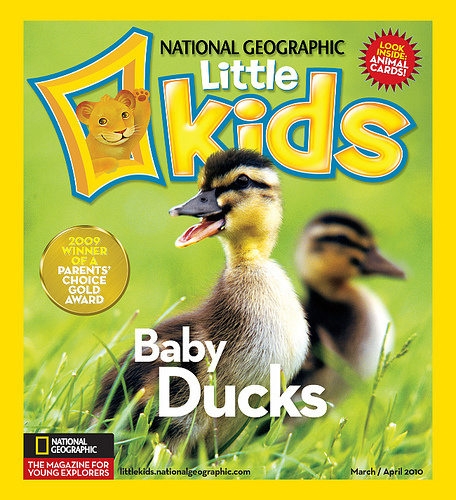
--------------
Showy Lady Slipper (reginae)
-
- The "showy" is difficult to find, it is not likely you will see it on a regular trail; it has to be sought out and will mean tramping through a bog. The reward of seeing this beautiful flowery product of nature is one a flower lover will treasure. The description of the showy lady's slipper will be much like that of the yellow lady's slipper except it is considerably larger, indeed, the tallest of our northern native orchids. Its stout, hairy, often twisted, leafy stalk bears one to three large flowers with a white and pink, pouch-like lip petal. The lip is upwards to three inches long; the leaves up to ten inches long, ribbed and elliptic. They will be found in "swamps, moist woods, especially limestone sites." (Audubon.) The "showy" likes calcareous soil, so look for alkaline bogs; its reported they are often to be found "in tamarack swamps." (Holland.) A warning is appropriate: the "glandular hairs of the foliage may cause a rash similar to that caused by Poison Ivy." (Audubon.)

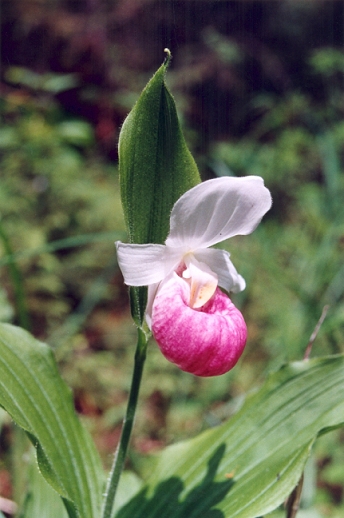
_______________________________
----------------
Pasture Rose (Rosa Virginiana and/or carolina)
- The familiar wild rose of Nova Scotia grows on a shrub which can be 1
to 4 feet tall. The flowers, which are in abundance over the tops of
the shrub, are showy and fragrant. Though I have seen white ones and red
ones, normally, the flowers are pink and found at the tip of thorny
stems. The flowers have five petals and develop into reddish or orangish
fruits, rosehips. Roland makes a distinction between the virginiana and the carolina, viz., the virginiana
"is a coarser plant throughout ... stouter and broader-based ...
flowers are almost always borne on branches from the old wood." The carolina
is a smaller bush and "shoots from the ground will often bear flowers
on the first year's growth." Roland suggests that considerable field
work needs yet to be done on these two common wild roses of Nova Scotia.
Roses will flower throughout the growing season, but slow down as
August comes. The rosehips fatten up during the last of the summer and
will remain on the bush, if undisturbed, through to spring and are a
source of food to our little overwintering friends in the forest. As
indicated by their name, a pasture rose is usually found out in the
open. It likes sandy or rocky places. "... wet pastures, thickets and
common along the heads of the salt marshes, dykelands and swamps."
(Roland.)
Edibility: Rosehips are rich in Vitamin C; there is as much Vitamin C in three small rosehips as there is in a large orange. They can be made into jams, jellies and syrups. (See McLeod, p. 58, for recipes.) Either dried flowers or rosehips can be used to make tea.

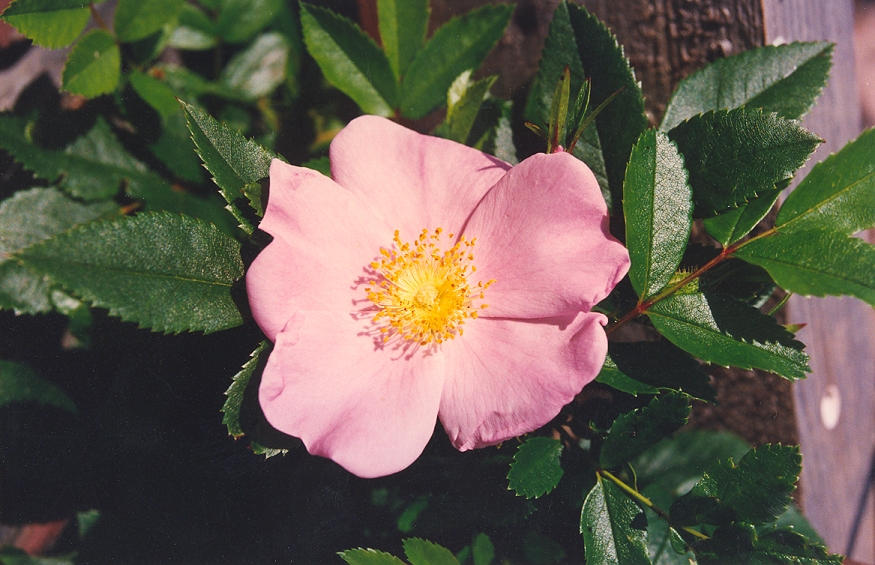
(Hi Res available email blupete) 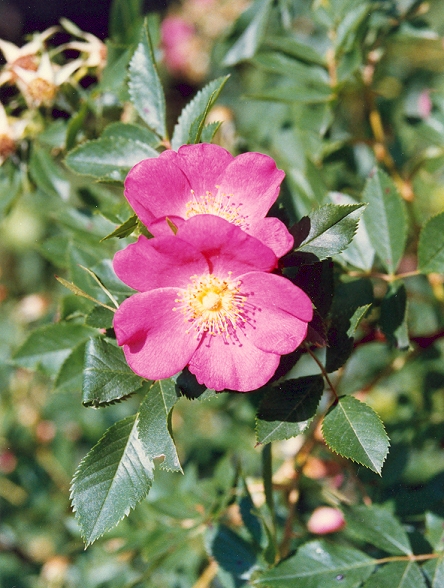
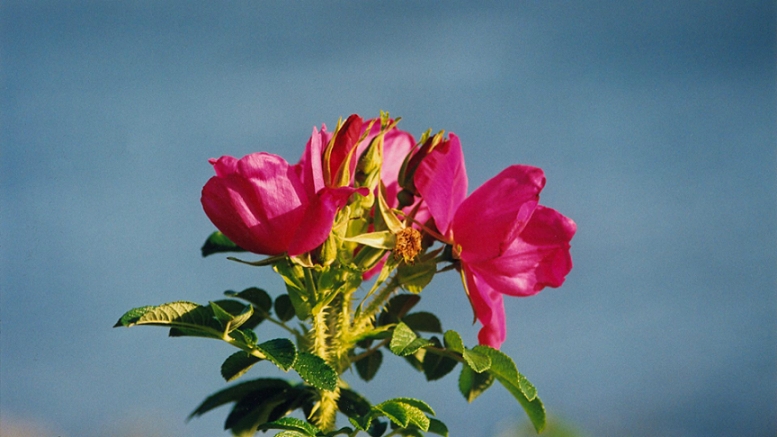
(Hi Res available email blupete)
_______________________________
-----------------------
adults...
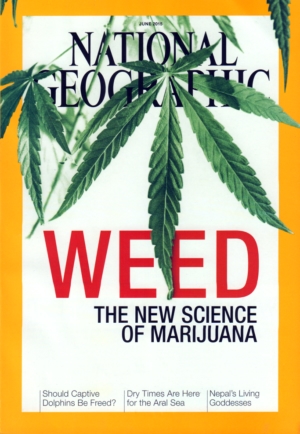
----------------
The Aster
-
- Asters form a large genus, of which, in North America, there are numerous species.
The display of flowers of the aster is usually fairly dense. As the
name would indicate (aster is Greek meaning star), the flowers of the
aster are showy and radiated.
The asters are the latest blooming wild flowers we have here in Nova Scotia. One will spot them as showy bouquets as summer concludes and late into the autumn. They flower profusely in pinks and blues and whites until a series of frosts takes them away. While the aster is a readily identifiable genus, it is one which presents a considerable challenge if one is to sort out the 19 varieties listed in Roland. The five most common asters in Nova Scotia, are: the umbellatus, the acuminatus, the nemoralis, the lateriflorus, and radula.
White Aster (umbellatus): This aster will be found in your first hunt: its white and tall and common. It likes wet ground. Audubon describes the white aster as bearing its flowers in flat-topped clusters which clusters can stretch to being a foot wide. The plant itself, can grow to quite a large size: one to seven feet.
Wood Aster (acuminatus): The wood aster prefers drier soils and is usually found handy to the hardwoods (deciduous).
Bog Aster (nemoralis): This aster is "low and wiry" with only one or a couple of lilac-purple flowers upon its stem.
Tiny Aster (lateriflorus): Roland describes it as tiny and much branched with numerous small flowers. It is abundant throughout the province.
Atlantic Aster (radula): This aster is ascribed by Roland as being one that is more common to the Atlantic side of the province. Its habitant: "boggy barrens, peaty swales, bogs and damp thickets."
- Asters form a large genus, of which, in North America, there are numerous species.
The display of flowers of the aster is usually fairly dense. As the
name would indicate (aster is Greek meaning star), the flowers of the
aster are showy and radiated.

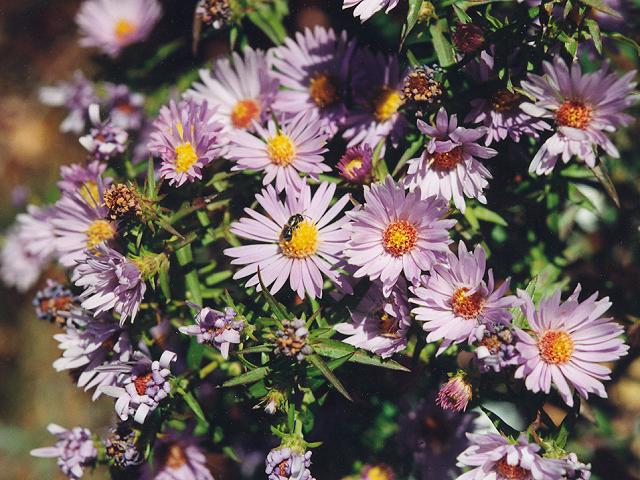
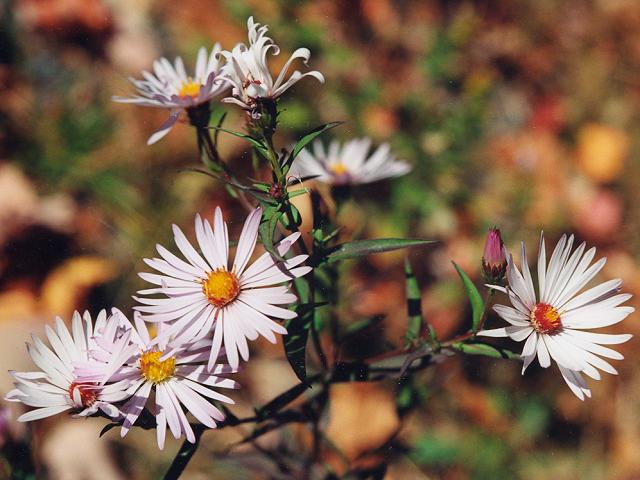
(Hi Res available email blupete)
(Hi Res available email blupete)
(Hi Res available email blupete)
_______________________________
The Blueberry
-
- The wonderful blueberry -- of which the animal kingdom (including humans) are very fond -- is completely at home in the acidic soils of Nova Scotia. The common Nova Scotian variety is, Vaccinium angustifolium. This low growing bush likes dry places, especially the rocky barrens; they do not do well in open sunny places. I show the blossoms, but it is the famed blue berry that is sweet to the tooth of the native animal populations. One of my favourite deserts is blueberry pie.

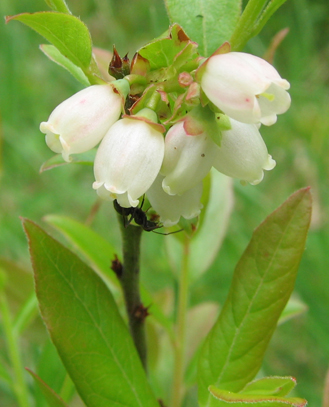
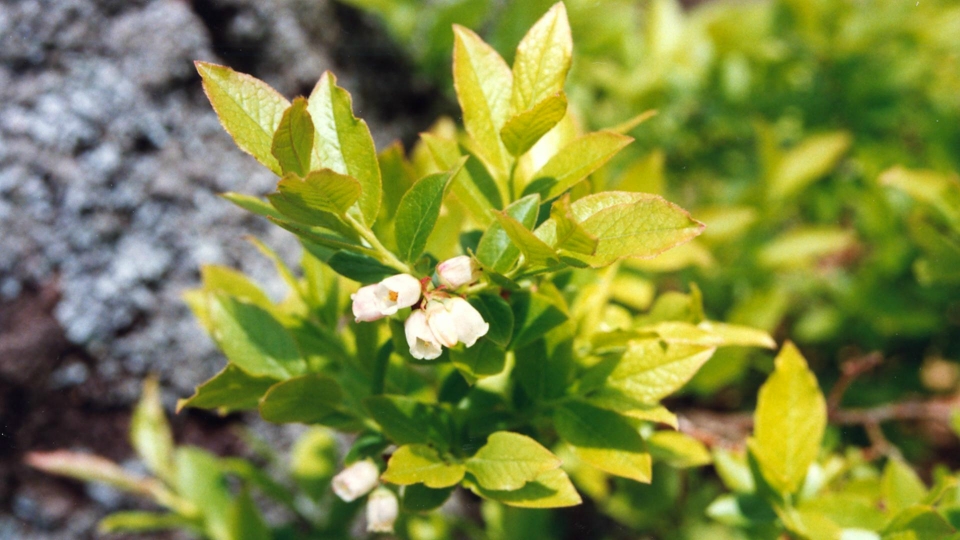
_______________________________
SHE'S CALLED NOVA SCOTIA- RITA MACNEIL
-








No comments:
Post a Comment
Note: Only a member of this blog may post a comment.